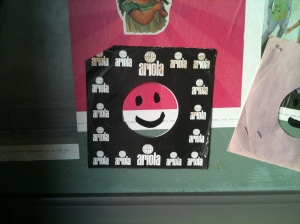In October I took part in the DAH Institute at the Royal Irish Academy. The theme of the Institute was Networks – all sorts of ideas spring to mind when you think of Networks – networked data, digital networks, networked society. But I’m more interested in networks of people and networks of ideas. So my talk focused on networks of people and how they collaborate in digital humanities.
Here are some of my key points from my presentation about how to work collaboratively. Each point is accompanied by spectacular images from Flickr Commons. Ruth the acrobat is a personal favourite.
Don’t Assume.
 There are multiple definitions of what the Digital Humanities actually is – my definition of DH maybe very different to your definition (and that is great). But when you embark upon a collaborative project – and the likelyhood is as you climb the academic ladder, or if you move out of academia to work in industry, cultural heritage etc you will have to work collaboratively.
There are multiple definitions of what the Digital Humanities actually is – my definition of DH maybe very different to your definition (and that is great). But when you embark upon a collaborative project – and the likelyhood is as you climb the academic ladder, or if you move out of academia to work in industry, cultural heritage etc you will have to work collaboratively.
When you embark upon a collaborative project there is a presumption that you are all talking in the same language. You will make assumptions about the other persons discipline and vise versa.
- At the beginning of a collaborative project spend the time just talking.
- Don’t rely on email because things can get lost in translation.
- It’s really important to have a common language.
- Spend time building relationships and understandings and figuring out how you all measure success at the start.
- Don’t assume (it makes an ass out of you and me)
- You can set criteria at the beginning but due to the nature of research, criteria can shift and this needs to be managed and communicated which leads nicely on to…
Be flexible.
Be like Ruth the acrobat – be flexible. Learn to adapt and to compromise. Both in terms of Time and Space – Flexibility, adaptability and accepting change and dealing with it.
Be Selfish.
(I couldn’t find a nice image to represent this)
This might seem out of context when talking about collaboration. But it is very important to be clear about what you are going to get out of the project, and out of the collaboration. What is going to further your aims? Be clear about what you and your collaborators want to get out of it from the beginning.
Think Outside the box.
This is a postcard from 1925 held in State Library and Archives of Florida. Meant to represent thinking outside the box.
Thinking outside the box, establishing multidisciplinary research teams and international collaborations with galleries, libraries, archives and museums, institutions outside academia. Start to push the boundaries of existing technologies and methodologies. Ask more questions. Aim to create an environment which is open to experimentation and innovation.
Innovation and experimentation are closely related to Risk. But how much risk is too much risk? This is an important question which needs to be explored. I think we need to create a culture in academia that embraces risk is a prerequisite to allow significant innovation to take hold. Take risks, and don’t be afraid to fail. Failing means we learn how to do things better next time.
There is plenty of discussion about collaboration in Digital Humanities, and everyone will work collaboratively in different ways, that is why it is so exciting. These are my 4 key points, what are yours?









 Just before Christmas I decided to revamp my reader, and asked for recommendations on some new good blogs that I should be reading. Anything Museumy, DHy, or generally pretty were the three key ingredients. Some I already followed, some are new. Thanks to everyone who gave me some recommendations. I thought I would share; so here’s a list of the blogs that I pay most attention to:
Just before Christmas I decided to revamp my reader, and asked for recommendations on some new good blogs that I should be reading. Anything Museumy, DHy, or generally pretty were the three key ingredients. Some I already followed, some are new. Thanks to everyone who gave me some recommendations. I thought I would share; so here’s a list of the blogs that I pay most attention to:
 Today I took part in a live chat panel on the
Today I took part in a live chat panel on the 